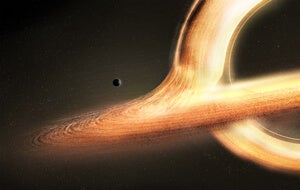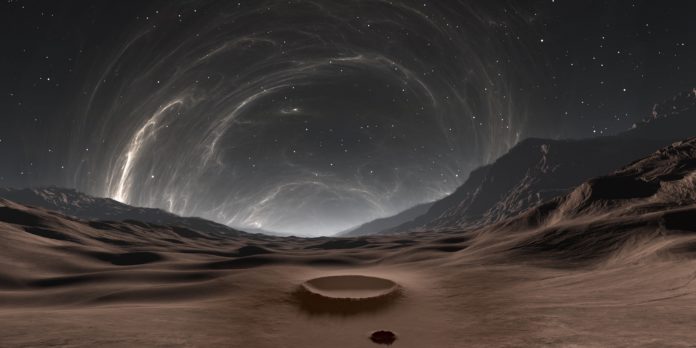“If the transcension hypothesis is correct, inner space, not outer space, is the final frontier for universal intelligence. Our destiny is density.”
–John Smart
Only decades into our “age of cosmology” — the moment when we earned the technological rights to peer deep into our cosmic home — we’ve learned that we live in a mega-palace of a universe. And we’ve also found something odd. We seem to be the only ones home! Where are the aliens? Was it something we said?
Within just a single generation, powerful telescopes, satellites, and space probes have given us tools to explore the structure of our universe. And the more we find; the more we discover how fine-tuned it could be for life. At least in our own solar system, organic compound-glazed comets drift everywhere. Some scientists suggest that one of these life-triggering ice balls crashed into Earth billions of years ago, delivering the conditions for chemistry and biology to take root. If the rest of the universe is similarly structured, we should be inside a life-spawning factory of a universe.

Just consider the mind-boggling numbers.
Even the most conservative NASA estimates say our universe has 500 billion billion stars like our own, and orbiting those suns are another 100 billion billion Earth-like planets. That is 100 habitable planets for every grain of sand on Earth. That’s trillions of opportunities for some other planet to grow life.
For argument’s sake, if even just a tenth of a percent of those planets capable of supporting life harbored some version of it, then there would be one million planets with life in the Milky Way Galaxy alone. A few might even have developed civilizations like our own, and cosmically thinking, if even just a handful of alien civilizations have advanced beyond our current level of technological progress, humanity should be waking up to a universe like the world of Star Trek.
But so far, no Ferengi, Klingons, Vulcans, Romulans—nobody.
Enrico Fermi, an Italian physicist, pointed out all of this weirdness in an observation that was later named for him: “the Fermi Paradox.” The paradox highlights the contradiction between the high probability that life would emerge in our universe, and the utter lack of evidence that advanced life exists anywhere else.
And it’s not just SETI signals we’re after — the paradox highlights that some advanced civilization that predates us has had enough time to fill our galaxy with spacecraft and other forms of blinking lights.
So, it should seem strikingly weird that we haven’t spotted anyone else.
There are no shortage of theories seeking to account for the Fermi Paradox. Entire lists of would-be explanations exist and if you have the time to spend down that rabbit hole (it’s a fun one), a recommended brain vacation is this excellent summary at Wait But Why.
But let’s focus on another emerging contender of a theory — virtual reality is to blame.
To address the Fermi Paradox, futurist John Smart proposes the fascinating “transcension hypothesis” theorizing that evolutionary processes in our universe might lead all advanced civilizations towards the same ultimate destination; one in which we transcend out of our current space-time dimension into virtual worlds of our own design.
According to Smart, as a species moves into its technologically advanced stage of progress, it develops virtual environments that exist on computers infinitely smaller than the ones we use today. Advanced species don’t colonize outer space — an idea they’d find archaic — but instead colonize inner space.
Smart proposes that our current efforts to explore parts of our solar system and beyond are just the adolescent stages of a technologically young species. We may continue to send space probes, satellites, and even courageous members of our own species into parts of our galaxy, but eventually those efforts are overwhelmed by the allure of infinite possibilities inside worlds of our own creation.
 Our virtual future may lie in “black-hole-like” environments that our computationally advanced descendants will build.
Our virtual future may lie in “black-hole-like” environments that our computationally advanced descendants will build.
Computers of 40 years ago were the size of buildings, yet today we carry far more powerful ones in our pocket. Our tendencies to compress computation into smaller and smaller environments leads Smart to propose that eventually we’ll create near-infinitely small computers far more powerful than today’s.
How these infinitely small computers function is still a matter of theoretical physics and computer science, but Smart points out that there is a “vast untapped scale” of reality below the level of the atom far more broad than the plane of reality we fleshy pieces of biology inhabit. Inner space engineering, as Smart calls it, may take place in the femtoscales of reality currently out of reach by today’s tools of technology. Eventually Smart theorizes that an advanced species may even harness the spooky weirdness of black hole physics to harness their event horizons for computational density that could process entire universes of virtual realities.
If recent advancements in computing make the transcension hypothesis a little more palatable, the recent and sudden wave of progress in virtual reality adds a touch more plausibility. And combining the two: Perhaps, it’s reasonable to assume that over time, our virtual worlds will become indistinguishable from our current reality.
Soon, we won’t visit the Internet from the glass window of our computer screens, but rather walk around inside it as a physical place. Philip Rosedale, the creator of Second Life, recently announced plans for a bold new virtual universe with a potential physical game map as large as the landmass of Earth. Essentially, he’ll create a virtual world with its own laws of physics, and once he’s pressed play, a newly formed universe will have its own “let there be light” creation moment.
Where we go from there will be stunning to watch.
As we continue our plunge into virtual spaces, the validity of the transcension hypothesis will come into sharper focus. If technology trends toward a world of microscopic computers with infinitely complex realities inside, this might explain why we can’t see any alien neighbors. They’ve left us behind for the digital wormholes of their own design.
Of course, there are holes to be poked in any far-reaching theory about our place in the cosmos, and for now much of this speculating requires generalized conclusions based on a limited understanding of reality. We don’t have enough data yet, and for now we’re settled into the discomfort of “we just don’t know.”
In the meantime, and until science can catch up with our imagination — it’s fascinating to ponder a future living inside virtual realities of our own choosing.
Of course, it’s also possible that we’re already there.
Image Credit: Shutterstock, NASA



